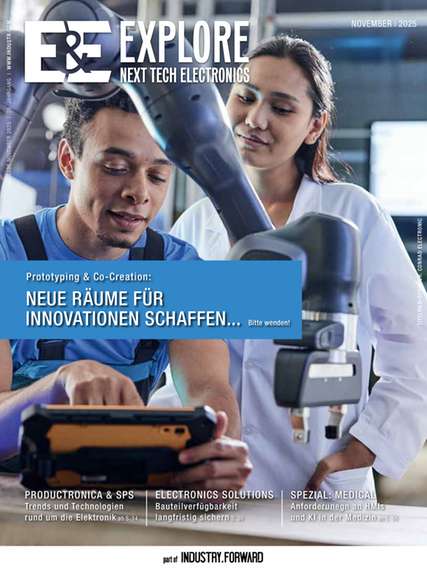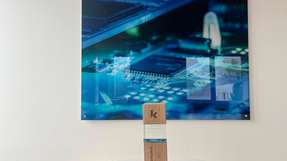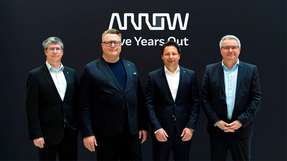The EBVchips program was launched in 2010 and was presented to the public at electronica. The idea behind it is as simple as impressive: A distributor is designing it‘s own semiconductors. Many inputs are based on the EBV�??s Vertical Sales Segments but the EBVchips program is available for every customers.But what sounds so simple is of course far more complicated. „Together with our customers we are creating new devices that are not existing today“, explains Antonio Fernandez, Director Technical Marketing at EBV. „It supports our customers to speed up their time-to-market, to achieve their project targets, to get higher efficiency and at the end of the day to be more competitive. On the other hand it helps us to strengthen the relationship with our customers and it contributes to strengthening the relationship with the suppliers as well. Because for suppliers it opens new business opportunities in new markets which means additional business. explains Antonio Fernandez. „Of course it is also a competition between the suppliers. But we offer all of them the possibility to engage in the EBVchips program.“ The decision, according to Antonio Fernandez, is based on the technical capabilities of a supplier and his engagement with the project. „Ultimately it has to be a win-win-win situation for our customers, the suppliers and for us“, Bernd Schlemmer, Director Communications EBV, adds. „We will only be succesful if we generate something that is not available yet. EBVchips was never meant to replace something that is available.“ „It is very helpful that our suppliers are providing us with information not only what is exisiting today, but also with what they have on their roadmap“, Antonio Fernandez points out. „This way we can avoid developing products that are already on the roadmaps of our suppliers“. Suppliers very often are focusing on big markets and accounts - leaving out the interests of a lot of small and midsized companies that have completely different needs. „That‘s why we launched EBVchips“, Antonio Fernandez says.
Collecting ideas
The first step in the development of each EBVchip is the discussion with customers - which does not always lead to a new EBVchip, though. „The EBVchips program aims at achieving the best solution for our customers“, Antonio Fernandez explains. „It happens frequently, that the device they are looking for already exists or will be available in a short period of time.“ So only if a device is neither existing nor forecasted, it will be newly developed as an EBVchip - with the input from as many customers as possible. The main difference to customized products is that the customers do not have to pay the development costs and do not have to commit to minimum order quantities. The financial risk is taken by EBV. The company takes care of the development costs and makes sure that the minimum order quantaties will be reached by adding up the volumens of the different customers who are interested in buying. „It‘s really a co-creation between a community of customers, a supplier and EBV.“
Work for experts
Design and manufacturing are made by the supplier EBV chooses for the project. „We are convinced that everybody should take the part where he is experts on“, Antonio Fernandez says. „Our suppliers are experts on designing, on manufacturing, on quality handling, so we leave that to them. „ Bernd Schlemmer adds: „We have the idea, we have the specifications, we hopefully have the markets and the customers - everything else is done by the supplier.“ The products do not even have an EBV-Brand on it. So like with a standard product, the supplier is responsible, which means that there is no risk for the customer. EBV is concentrating on its own strengths: „We support our customers in choosing the right device, during the process of development, in logistics, procurement and after market“, Antonio Fernandez sums it up. „If our customers have an issue, we help them overcome the problem.“ But of course EBVchips is much more than helping the customers, it is a big investment - an investment in the customers, as Antonio Fernandez points out. „This is a big differentiation for us compared to traditional distribution. We are investing in the projects of our customers for four or five years before having a return on investment“. This means for EBV taking the risk that the volumes will not be as high as forecasted or some projects will be cut dead. „We want to commit more to our customers“ Antonio Fernandez says. „We want to show them that especially now, when things are tough, we are investing in them. A part of our profit is invested in our customers - that‘s part of the innovation of the EBVchips program.“ All EBVchips are exclusively distributed by EBV for a given period of time, depending on the company‘s investment. After that time, the devices will be available in the open market. And although EBV is only operating in the EMEA region, the products are available worldwide. „If customers outside of our region are interested in EBVchips, we will help them via our colleagues from the Avnet organisation.“ Antonio Fernandez adds: „It‘s really a world wide program. We develop in EMEA, but the products are available for every customer.“
The start
The first available product from the EBVchips program was Genesis, an IGBT-Module with SiC diodes for high-performance inverters. It was developed with Vishay and manufactured in Italy. But it was more than just a first product, because it brought a lot of experience into EBV to be able to make customized modules. „We developed the know how to make all kinds of customized modules in power electronics - different topologies, different semiconductors, different packages“, Antonio Fernandez explains. „So now we are able to discuss with our customers any kind of high-power stage. Genesis was a very important project for us to understand the market and how to build this kind of products.“The next step was a family of heavy duty pressure sensors. The Titan sensors, developed with Sensata Technologies, are especially suited for air conditioning, heating appliances, heat pumps or compressors. EBV included an electronics module with a 4-20mA current interface inside of the typical sensor. This current interface brings a lot of advantages for the industrial environment, because it is less prone to errors, allows higher distances and is powered through the same cable.
Large variety of new products
But this was just the start - at electronica EBV will show a significant number of new members of the EBVchips program. There will be vTARIC, a chip for the automotive industry. It includes an ASIC and a microcontroller for smart alternator regulation. The device was developed with STMicroelectronics and is a two-die device in a single package and - of course - it´s automotive-qualified. „Until now, electronics were based directly inside of the alternator regulator. With vTARIC, the customer can develop the basic electronics and just with a change of the software use it for different kinds of alternators“, Antonio Fernandez explains the advantages. vTARIC is scheduled to ship in May 2013. Another device for the automotive industry comes from a collaboration with Freescale. It can be used for low emission engine control and helps customers to comply with the strict emission regulations. „This device was originally developed by our partner Freescale with some automotive key accounts“, Antonio Fernandez explains. „We want to make this available for the distribution and for the industrial market.“ It is obvious that industrial customers controlling Solenoids also have a need for higher precision and minimized power consumption. Two other products aim also at the industrial market. One will be an isolation amplifier for current measurement, developed with Avago. „This is basically a Delta Sigma modulator with LVDS interface“, Antonio Fernandez points out. „The LVDS interface is perfect to connect the Delta Sigma modulator with FPGAs with low noise - which leads to higher data integrity and more precise motion control.“ This device is included in EBV‘s reference design FalconEye. Also for motion control is a MOSFET bridge with protection, developed for use in low voltage DC motors. This one, too, is a cooperation with Vishay, who were already the partner for the Genesis module.Besides the heavy activities in automotive and industrial markets, EBVchips also aims at the market for renewable energies with a semiconductor for metering bus applications. The chip, A M-bus slave transceiver, designated Hermes is a collaboration with On Semiconductor. Adressing the needs of devices that are powered by battery and include power-intense parts like radio transmission, Hermes helps to optimize the power consumption. „It‘s a device to support development of more efficient metering networks“, Antonio Fernandez sums up the advantage. Energy efficiency is something everyone at EBV is very aware of. Kicking off the company‘s „ECOmise it” programm a few years ago, one of the main targets of EBVchips is energy effiency. „Apart from all technical features, energy efficiency is a must for us“ Antonio Fernandez says. „The products must contribute to decrease the power consumption and at the end to contribute to environmental protection.“
Revolutionary service
So there‘s a lot of products coming up in the EBVchips program, although Antonio Fernandez sees this only as the beginning. „EBVchips program is in evolution. We are getting a lot of experience out of it. This is the next step in distribution, in value added services, because this program strengthens the relationship between EBV, our customers and partners even more.“ To keep this going, EBV has increased the ressources for support to the EBVchips. A product application manager is now fully dedicated to everything that is related to the technical aspects of EBVchips. Antonio Fernandez explains: „It is a very complex program. To make semiconductors, to make this co-creation with customers and with suppliers is all but easy. It is taking time, it is taking passion, it is taking a lot of investment and it is also requiring a very high technical involvement.“ And as he explained earlier on, it takes a lot of investment in the EBV customers. „But the reason of our existence is our customers, so we are providing probably the most revolutionary service in the industry for them.“













